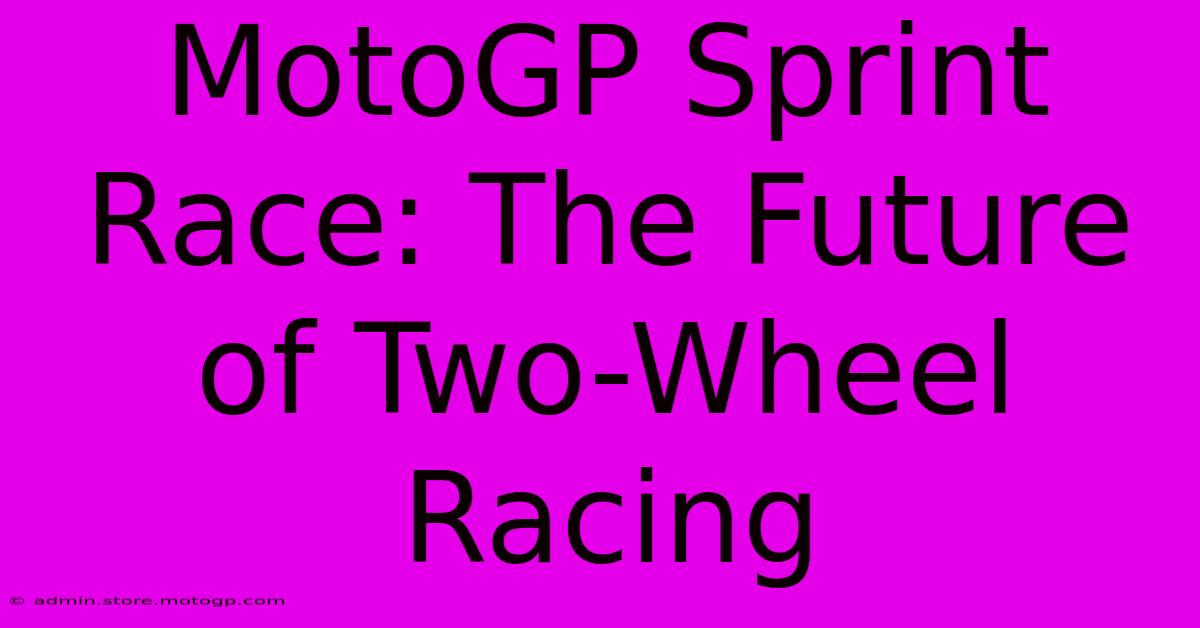MotoGP Sprint Race: The Future Of Two-Wheel Racing

Table of Contents
MotoGP Sprint Race: The Future of Two-Wheel Racing?
The roar of the engines, the smell of burning rubber, the breathtaking speeds – MotoGP has always been synonymous with adrenaline-fueled excitement. But in 2023, a significant change hit the grid: the introduction of the Sprint Race. This shorter, faster format has ignited debate, with some hailing it as the future of two-wheel racing, while others question its impact on the sport. Let's delve into the implications of this thrilling addition to the MotoGP calendar.
What is a MotoGP Sprint Race?
The Sprint Race is a shorter race, typically around half the distance of the main Grand Prix race, held on the Saturday afternoon before the main Sunday race. Points are awarded to the top nine finishers, although the points allocation is lower than the main race, adding a significant layer of strategy and competitiveness to the weekend. This means that even a poor qualifying session doesn't completely eliminate a rider's chances for a good overall weekend result.
The Impact on the Weekend Schedule
The introduction of the Sprint Race has significantly altered the MotoGP weekend schedule. Friday remains dedicated to free practice sessions, but Saturday now features qualifying followed immediately by the Sprint Race, making for a jam-packed and intensely exciting day. This condensed format means higher stakes and less room for error. The change necessitates greater stamina and precision from riders and teams alike, leading to a more demanding overall weekend.
Arguments For the Sprint Race
- Increased Excitement and Viewership: The Sprint Race delivers fast-paced action, significantly boosting the weekend's entertainment value. It provides an extra dose of racing to fans both in the stadium and watching at home, potentially increasing viewership numbers and engagement.
- Enhanced Competition: The shorter format offers more opportunities for overtaking and strategic maneuvers. This reduces the impact of a single error and provides riders with a better chance to gain positions. This ultimately increases the competitiveness of the championship.
- More Data and Learning: The additional race provides teams and riders with valuable extra data regarding bike setup and race strategies, potentially leading to improvements in performance over the whole season.
- Better Value for Fans: A two-race weekend might feel like better value for money for spectators and viewers alike. They get more racing for their ticket or viewing time.
Arguments Against the Sprint Race
- Increased Rider Fatigue: The back-to-back races over the weekend put a significant strain on riders, potentially increasing the risk of injury and burnout. This added pressure could potentially lead to more accidents.
- Potential for Diminished Main Race Importance: Some argue that the Sprint Race might overshadow the main Grand Prix, reducing its overall prestige and impact on the championship standings.
- Added Pressure on Teams: The demands on teams also increase; more work is required in a shorter space of time, with less opportunity for rest and recovery between sessions. This can lead to increased costs and strain on personnel.
- Risk of Injury and Mechanical Failures: The added race increases the risk of both rider injury and mechanical failure due to the increased pressure and strain on both riders and machinery.
The Future of MotoGP and Sprint Racing
The introduction of the Sprint Race marks a significant turning point for MotoGP. While concerns exist regarding rider fatigue and the potential to dilute the main race's importance, the undeniable increase in excitement and engagement is hard to ignore. The success of the Sprint Race will likely be determined by its long-term impact on the sport's overall health, rider safety, and the continued engagement of fans. Only time will tell if this new format truly represents the future of two-wheel racing or whether adjustments will be necessary to optimize its effectiveness and sustainability. The ongoing data analysis and feedback from riders, teams, and fans will play a crucial role in shaping the future of MotoGP and the role of the Sprint Race within it.
Keywords: MotoGP, Sprint Race, MotoGP Sprint Race, Motorcycle Racing, Two-Wheel Racing, Grand Prix, Motorcycle Grand Prix, MotoGP News, Motorsports, Racing, Formula 1, Motorcycles, Race Strategy, Weekend Schedule, Rider Fatigue, Championship Standings, Viewership, Excitement, Competition
Meta Description: The introduction of the MotoGP Sprint Race has sparked debate. Is it a thrilling addition to the sport, or a detrimental change? We explore the arguments for and against.

Thank you for visiting our website wich cover about MotoGP Sprint Race: The Future Of Two-Wheel Racing. We hope the information provided has been useful to you. Feel free to contact us if you have any questions or need further assistance. See you next time and dont miss to bookmark.
Featured Posts
-
The Sound Of Speed Moto Gp Pictures That Roar
Feb 19, 2025
-
Get The Best F1 Us Grand Prix Tv Coverage Insider Tips
Feb 19, 2025
-
Cota Parking Get To The Race Faster With Our Parking Map
Feb 19, 2025
-
F1 Austin Simple Tv Schedule Maximum Excitement
Feb 19, 2025
-
Moto Gp Desmosedici Unrivaled Performance
Feb 19, 2025
